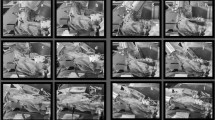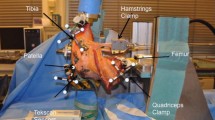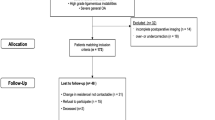Abstract
Purpose
Valgus high tibial osteotomy (HTO) and a recently introduced extra-articular absorber have been shown to efficiently unload the medial compartment of the knee. However, only little is known about the influence of these treatment modalities on biomechanics of the patellofemoral joint. The purpose of this study was to investigate and compare the impact of different HTO techniques and implantation of an extra-articular absorber on patellofemoral contact forces.
Methods
Fourteen fresh frozen cadaveric knees were tested in a specially designed knee simulator that allowed simulation of isokinetic flexion–extension motions under physiological loading. Mean contact pressure (ACP) and peak contact pressure (PCP) of the patellofemoral joint was measured continuously between 0° and 120° of knee flexion using a pressure sensitive film in the following conditions: native, after biplanar medial open-wedge HTO with 5° and 10° correction angle performing an ascending frontal osteotomy of the tibial tuberosity, and after implantation of an extra-articular absorber system (KineSpring®). Including a second testing cycle with a biplanar medial open-wedge HTO with 5° and 10° correction angle performing descending frontal osteotomy of the tibial tuberosity. Values after each procedure were compared to the corresponding values of the native knee.
Results
Biplanar proximal osteotomy leaded to a significant increase of retropatellar compartment area contact pressure compared to the first untreated test cycle (Δ 0.04 ± 0.01 MPa, p = 0.04). Similar results were observed measuring peak contact pressure (Δ 1.41 ± 0.15 MPa, p = 0.03). With greater correction angle 5°, respectively, 10° peak and contact pressure increased accordingly. In contrast, the biplanar distal osteotomy group showed significant decrease of pressure values (p = 0.004). The extracapsular, extra-articular absorber had no significant influence on pressure levels in the patellofemoral joint.
Conclusion
HTO with a proximal biplanar osteotomy of the tuberositas tibia significantly increased patellofemoral pressure conditions depending on the correction angle. In contrast a distally directed biplanar osteotomy diminished these effects while implantation of an extracapsular, extra-articular absorber had no influence on the patellofemoral compartment at all. Consequently, patients with varus alignment with additional retropatellar chondropathia should be treated with a distally adverted osteotomy to avoid further undesirable pressure elevation in the patellofemoral joint.






Similar content being viewed by others
References
Agneskirchner JD, Hurschler C, Stukenborg-Colsman C, Imhoff AB, Lobenhoffer P (2004) Effect of high tibial flexion osteotomy on cartilage pressure and joint kinematics: a biomechanical study in human cadaveric knees. Winner of the AGA-DonJoy Award. Arch Orthop Trauma Surg 2004;124(9):575–584
Block JA, Shakoor N (2009) The biomechanics of osteoarthritis: implications for therapy. Curr Rheumatol Rep 11(1):15–22
Bode G, Kloos F, Feucht MJ et al (2016) Comparison of the efficiency of an extra-articular absorber system and high tibial osteotomy for unloading the medial knee compartment: an in vitro study.;. Knee Surg Sports Traumatol Arthrosc 25(12):3695–3703
Bode G, Ogon P, Pestka J et al (2015) Clinical outcome and return to work following single-stage combined autologous chondrocyte implantation and high tibial osteotomy. Int Orthop 39(4):689–696
Bode G, Schmal H, Pestka JM, Ogon P, Südkamp NP, Niemeyer P (2013) A non-randomized controlled clinical trial on autologous chondrocyte implantation (ACI) in cartilage defects of the medial femoral condyle with or without high tibial osteotomy in patients with varus deformity of less than 5°. Arch Orthop Trauma Surg 133(1):43–49
Brandt KD, Dieppe P, Radin E (2009) Etiopathogenesis of osteoarthritis. Med Clin North Am 93(1):1–24
Brandt KD, Dieppe P, Radin EL (2009) Commentary: is it useful to subset “primary” osteoarthritis? A critique based on evidence regarding the etiopathogenesis of osteoarthritis. Semin Arthritis Rheum 39(2):81–95
Clifford A, O’Connell M, Gabriel S, Miller LE, Block JE (2011) The KineSpring load absorber implant: rationale, design and biomechanical characterization. J Med Eng Technol 35(1):65–71
Clifford AG, Gabriel SM, O’Connell M, Lowe D, Miller LE, Block JE (2013) The KineSpring(®) knee implant system: an implantable joint-unloading prosthesis for treatment of medial knee osteoarthritis. Med Devices Auckl NZ 6:69–76
El-Azab H, Glabgly P, Paul J, Imhoff AB, Hinterwimmer S (2010) Patellar height and posterior tibial slope after open- and closed-wedge high tibial osteotomy. Am J Sports Med 38(2):323–329
Floerkemeier S, Staubli AE, Schroeter S, Goldhahn S, Lobenhoffer P (2014) Does obesity and nicotine abuse influence the outcome and complication rate after open-wedge high tibial osteotomy? A retrospective evaluation of five hundred and thirty three patients. Int Orthop 38(1):55–60
Floerkemeier S, Staubli AE, Schroeter S, Goldhahn S, Lobenhoffer P (2014) Does obesity and nicotine abuse influence the outcome and complication rate after open-wedge high tibial osteotomy? A retrospective evaluation of five hundred and thirty three patients. Int Orthop 38(1):55–67
Gaasbeek R, Welsing R, Barink M, Verdonschot N, Kampen A van (2007) The influence of open and closed high tibial osteotomy on dynamic patellar tracking: a biomechanical study. Knee Surg Sports Traumatol Arthrosc 15(8):978–984
Gstöttner M, Michaela G, Pedross F et al (2008) Long-term outcome after high tibial osteotomy. Arch Orthop Trauma Surg 128(1):111–115
Hinterwimmer S, Beitzel K, Paul J et al (2011) Control of posterior tibial slope and patellar height in open-wedge valgus high tibial osteotomy. Am J Sports Med 39(4):851–856
Javidan P, Adamson GJ, Miller JR et al (2013) The effect of medial opening wedge proximal tibial osteotomy on patellofemoral contact. Am J Sports Med 41(1):80–86
Kim K-I, Kim D-K, Song S-J, Lee S-H, Bae D-K (2017) Medial open-wedge high tibial osteotomy may adversely affect the patellofemoral joint. Arthroscopy J 33(4):811–816
Krause M, Drenck TC, Korthaus A, Preiss A, Frosch K-H, Akoto R (2017) Patella height is not altered by descending medial open-wedge high tibial osteotomy (HTO) compared to ascending HTO. Knee Surg Sports Traumatol Arthrosc 26(6):1859–1866
Lobenhoffer P, Agneskirchner J, Zoch W (2004) Open valgus alignment osteotomy of the proximal tibia with fixation by medial plate fixator. Orthopade 33(2):153–160
Lobenhoffer P, Agneskirchner JD (2003) Improvements in surgical technique of valgus high tibial osteotomy. Knee Surg Sports Traumatol Arthrosc 11(3):132–138
Lützner J, Gross AF, Günther KP, Kirschner S (2010) Precision of navigated and conventional open-wedge high tibial osteotomy in a cadaver study. Eur J Med Res 15(3):117–120
Messier SP, DeVita P, Cowan RE, Seay J, Young HC, Marsh AP (2005) Do older adults with knee osteoarthritis place greater loads on the knee during gait? A preliminary study. Arch Phys Med Rehabil 86(4):703–709
Messier SP, Gutekunst DJ, Davis C, DeVita P (2005) Weight loss reduces knee-joint loads in overweight and obese older adults with knee osteoarthritis. Arthritis Rheum 52(7):2026–2032
Minzlaff P, Saier T, Brucker PU, Haller B, Imhoff AB, Hinterwimmer S (2015) Valgus bracing in symptomatic varus malalignment for testing the expectable “unloading effect” following valgus high tibial osteotomy. Knee Surg Sports Traumatol Arthrosc 23(7):1964–1970
Niemeyer P, Schmal H, Hauschild O, von Heyden J, Südkamp NP, Köstler W (2010) Open-wedge osteotomy using an internal plate fixator in patients with medial-compartment gonarthritis and varus malalignment: 3-year results with regard to preoperative arthroscopic and radiographic findings. Arthroscopy 26(12):1607–1616
Ostermeier S, Friesecke C, Fricke S, Hurschler C, Stukenborg-Colsman C (2008) Quadriceps force during knee extension after non-hinged and hinged TKA: an in vitro study. Acta Orthop 79(1):34–38
Ostermeier S, Hurschler C, Stukenborg-Colsman C (2004) Quadriceps function after TKA–an in vitro study in a knee kinematic simulator. Clin Biomech Bristol Avon 19(3):270–276
Staubli AE, De Simoni C, Babst R, Lobenhoffer P (2003) TomoFix: a new LCP-concept for open wedge osteotomy of the medial proximal tibia–early results in 92 cases. Injury 34(2):B55-62
Stoffel K, Willers C, Korshid O, Kuster M (2007) Patellofemoral contact pressure following high tibial osteotomy: a cadaveric study. Knee Surg Sports Traumatol Arthrosc 15(9):1094–1100
Waller C, Hayes D, Block JE, London NJ (2011) Unload it: the key to the treatment of knee osteoarthritis. Knee Surg Sports Traumatol Arthrosc 19(11):1823–1829
Yang JS, Fulkerson JP, Obopilwe E, Voss A (2017) Patellofemoral contact pressures after patellar distalization: a biomechanical study. Arthroscopy 33(11):2038–2044
Acknowledgements
Funding was provided by Müller-Fahnenberg Stiftung.
Funding
The study was funded by the Müller-Fahnenberg Study of Freiburg University.
Author information
Authors and Affiliations
Corresponding author
Ethics declarations
Conflict of interest
None of the authors has any conflict of interest.
Ethical approval
The ethics committee of Hannover University approved this study (ID 3083-2016).
Rights and permissions
About this article
Cite this article
Kloos, F., Becher, C., Fleischer, B. et al. High tibial osteotomy increases patellofemoral pressure if adverted proximal, while open-wedge HTO with distal biplanar osteotomy discharges the patellofemoral joint: different open-wedge high tibial osteotomies compared to an extra-articular unloading device. Knee Surg Sports Traumatol Arthrosc 27, 2334–2344 (2019). https://doi.org/10.1007/s00167-018-5194-x
Received:
Accepted:
Published:
Issue Date:
DOI: https://doi.org/10.1007/s00167-018-5194-x




